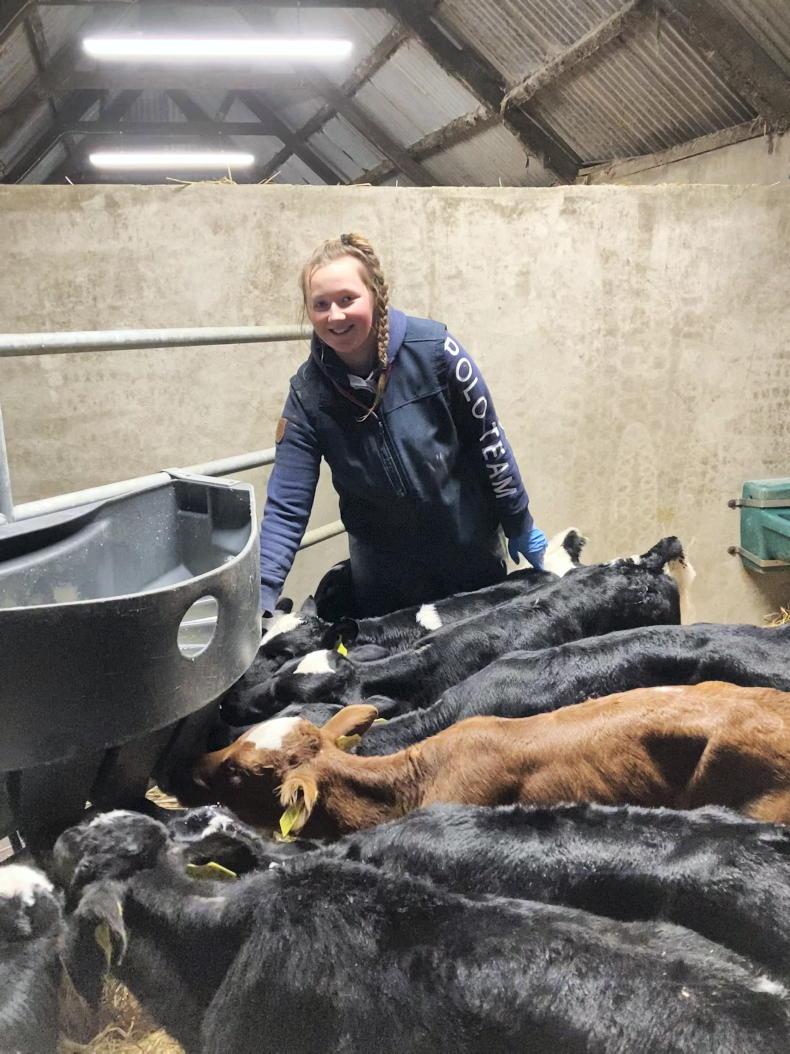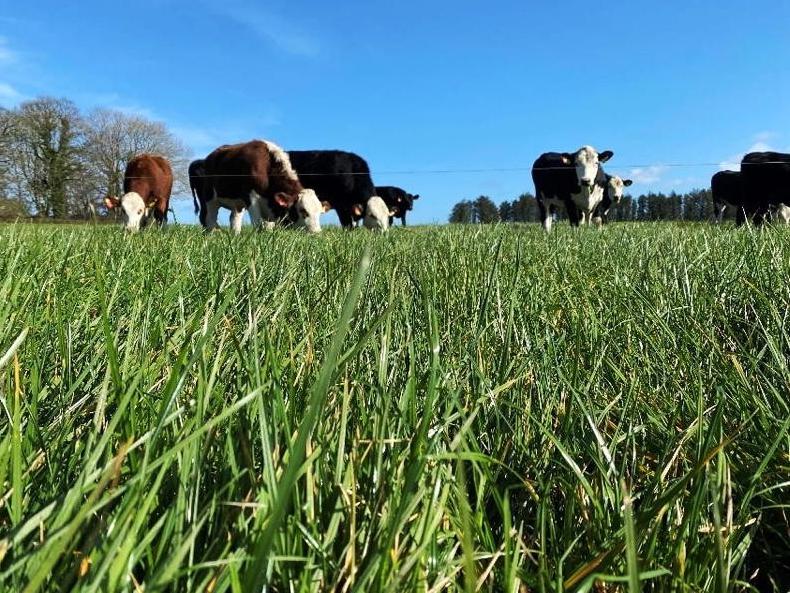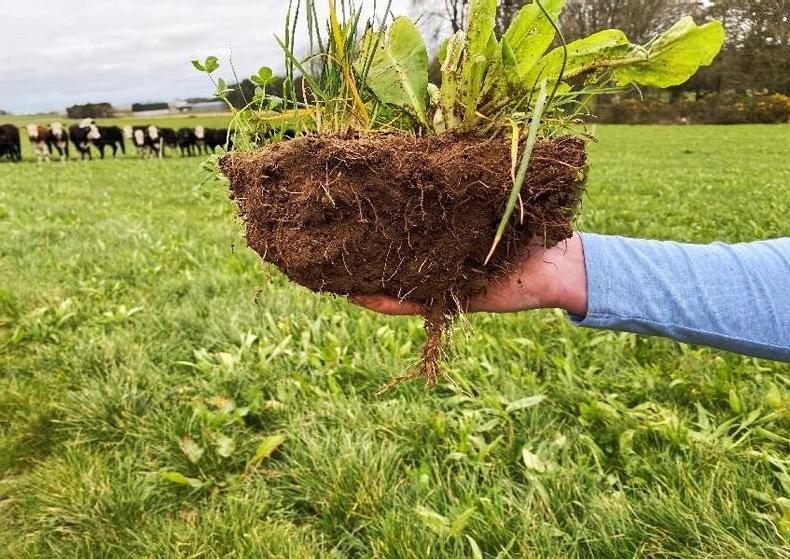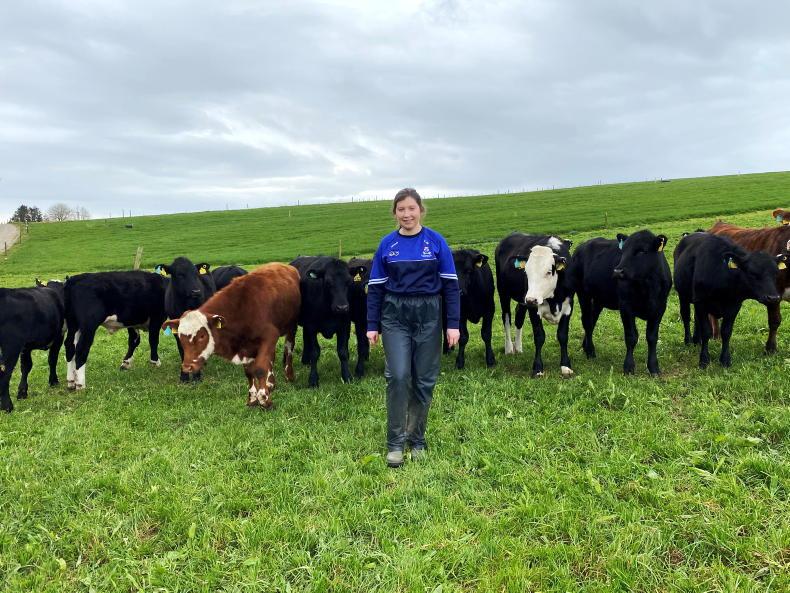The 2021 Agricultural Science Association (ASA) professional work experience (PWE) bursary is now in its sixth year.
Traditionally, the chosen students would have travelled abroad to complete their PWE. This year, however, the placements are being carried out on Irish soil.
Undergraduate students Kelly Duffin and Victoria Woods from Waterford Institute of Technology’s (WIT) agricultural department share their accounts of the 2021 programme so far.
My name is Kelly Duffin, my farming background is beef farming and I live in Kilhile, Co Wexford. At home we run a finishing system where we buy cattle at the mart and fatten them for the factory. I am a second year student, studying a BSc in agriculture. I am currently on a dairy farm owned by Pat and Carmel Banville, in Co Wexford.

Kelly Duffin feeding calves on her professional work experience at Pat and Carmel Banville's dairy farm in Taghmon, Co Wexford.
As I come from a beef background I had no dairy experience whatsoever and I have learned so much; such as how to set up the milking machine, milking, washing down the parlour, calving, calf rearing, disbudding and more.
Type of farm
This is a closed spring calving dairy herd, made up of pedigree Holstein Friesians. When I started on the 18 January there were 142 cows and 28 in-calf heifers and of this number there were 35 cows milking. Now there are 91 animals milking. The cows are milked at 7am and again at 4pm. The milking parlour is a DeLaval 10 double-up herringbone unit, with automatic cluster removers and dump line. Due to the wet weather in recent weeks the cows were kept indoors in the cubicle house which has automatic scrapers and the cubicles are scraped twice daily, bedded and limed.
When indoors, the cows are fed 4kg of dairy nuts in the parlour. They also get 3kg of home grown barley and a balancer mix in the diet feeder, along with silage and 0.5kg of straw. The cows went out to grass for the first time on 25 February. The cows will be left out grazing day and night, weather permitting. The grazing system used on the farm is paddock grazing with cow paths to each paddock.
Calving
Cows are moved to a straw-bedded shed one week before calving, which has individual calving pens and a calving gate in each for safety. There are also calving cameras in the shed. When the cow has calved, the calf’s navel is sprayed with iodine and they receive 3l of colostrum in the first two hours. Once the calf is licked dry they are moved to individual pens where they get fed transition milk for four days. They get started on meal in the individual pens.
After 10 days they get moved into group pens, where they are fed nuts and milk replacer. Pens are cleaned and washed regularly with a solution of water and disinfectant. Lime is then spread and the pens are finished with a straw bed. Calves get disbudded at three weeks and are given a vaccine against blackleg.
So far I am really enjoying my placement and improving my farm skills every day.
My name is Victoria Woods and I am a third-year ag science student. Currently, I am on work placement at the Teagasc Environmental Research Centre at Johnstown Castle. This placement began in January and will run until May.

Cattle grazing perennial sward, as part of multi species sward on the Johnstown Castle Research Farm.
I am placed on the beef farm in Johnstown Castle. This part of the farm facilitates two system farm trials. The first is a stocking density trial, which is in its final year and is due for completion in June. This experiment compares three different stocking rates, low 2.5 livestock units per hectare (LU/ha); medium (2.8LU/ha); and high (3.1LU/ha) and looks to compare these for the optimum stocking rate.
As part of this experiment animals are weighed biweekly, while housed and then once monthly at grass. I find it very interesting, paying such close attention to the animal’s growth rates and to see how their conditions – such as housing, change in diet quality and the change from silage to grass – can affect their growth

Soil profile showing the deep rooting of the chicory plant.
The second experiment is a multi-species experiment, which will progress over the next five years. This experiment sees three groups of cattle grazing across different conditions. The first group is on perennial rye grass (PRG), the second is on perennial rye grass and clover and the third is on perennial rye grass, clover, chicory, and plantain. The farm is set up in farm-lets so that the three groups of cattle can be ran side by side. As well as grazing, the animals they will also be fed the same type of silage.
Multi species swards are becoming ever more prevalent among Irish farms, as they have a positive effect on yields, with a lower nitrogen application rate. This can reduce fertiliser costs and will also reduce the environmental impact. The chicory has a positive effect on the soil structure, due to the tap root. Both the clover mix and multi species contain clover, which minimises the uses of nitrogen across these swards.
Along with the two farm system trials, there are also some animals which qualify under the environmental research programme on the farm. These animals (predominately Friesian males) come from the dairy herd in Johnstown with the remainder being bought in from local farmers.
I have been very fortunate to have the opportunity to take this placement at Johnstown castle. It’s been a very enjoyable placement so far and I know I will leave the placement with a reignited appetite for the great industry that is Irish agriculture.
Read more
Student Diary: back to the classroom
Life after an agricultural degree
The 2021 Agricultural Science Association (ASA) professional work experience (PWE) bursary is now in its sixth year.
Traditionally, the chosen students would have travelled abroad to complete their PWE. This year, however, the placements are being carried out on Irish soil.
Undergraduate students Kelly Duffin and Victoria Woods from Waterford Institute of Technology’s (WIT) agricultural department share their accounts of the 2021 programme so far.
My name is Kelly Duffin, my farming background is beef farming and I live in Kilhile, Co Wexford. At home we run a finishing system where we buy cattle at the mart and fatten them for the factory. I am a second year student, studying a BSc in agriculture. I am currently on a dairy farm owned by Pat and Carmel Banville, in Co Wexford.

Kelly Duffin feeding calves on her professional work experience at Pat and Carmel Banville's dairy farm in Taghmon, Co Wexford.
As I come from a beef background I had no dairy experience whatsoever and I have learned so much; such as how to set up the milking machine, milking, washing down the parlour, calving, calf rearing, disbudding and more.
Type of farm
This is a closed spring calving dairy herd, made up of pedigree Holstein Friesians. When I started on the 18 January there were 142 cows and 28 in-calf heifers and of this number there were 35 cows milking. Now there are 91 animals milking. The cows are milked at 7am and again at 4pm. The milking parlour is a DeLaval 10 double-up herringbone unit, with automatic cluster removers and dump line. Due to the wet weather in recent weeks the cows were kept indoors in the cubicle house which has automatic scrapers and the cubicles are scraped twice daily, bedded and limed.
When indoors, the cows are fed 4kg of dairy nuts in the parlour. They also get 3kg of home grown barley and a balancer mix in the diet feeder, along with silage and 0.5kg of straw. The cows went out to grass for the first time on 25 February. The cows will be left out grazing day and night, weather permitting. The grazing system used on the farm is paddock grazing with cow paths to each paddock.
Calving
Cows are moved to a straw-bedded shed one week before calving, which has individual calving pens and a calving gate in each for safety. There are also calving cameras in the shed. When the cow has calved, the calf’s navel is sprayed with iodine and they receive 3l of colostrum in the first two hours. Once the calf is licked dry they are moved to individual pens where they get fed transition milk for four days. They get started on meal in the individual pens.
After 10 days they get moved into group pens, where they are fed nuts and milk replacer. Pens are cleaned and washed regularly with a solution of water and disinfectant. Lime is then spread and the pens are finished with a straw bed. Calves get disbudded at three weeks and are given a vaccine against blackleg.
So far I am really enjoying my placement and improving my farm skills every day.
My name is Victoria Woods and I am a third-year ag science student. Currently, I am on work placement at the Teagasc Environmental Research Centre at Johnstown Castle. This placement began in January and will run until May.

Cattle grazing perennial sward, as part of multi species sward on the Johnstown Castle Research Farm.
I am placed on the beef farm in Johnstown Castle. This part of the farm facilitates two system farm trials. The first is a stocking density trial, which is in its final year and is due for completion in June. This experiment compares three different stocking rates, low 2.5 livestock units per hectare (LU/ha); medium (2.8LU/ha); and high (3.1LU/ha) and looks to compare these for the optimum stocking rate.
As part of this experiment animals are weighed biweekly, while housed and then once monthly at grass. I find it very interesting, paying such close attention to the animal’s growth rates and to see how their conditions – such as housing, change in diet quality and the change from silage to grass – can affect their growth

Soil profile showing the deep rooting of the chicory plant.
The second experiment is a multi-species experiment, which will progress over the next five years. This experiment sees three groups of cattle grazing across different conditions. The first group is on perennial rye grass (PRG), the second is on perennial rye grass and clover and the third is on perennial rye grass, clover, chicory, and plantain. The farm is set up in farm-lets so that the three groups of cattle can be ran side by side. As well as grazing, the animals they will also be fed the same type of silage.
Multi species swards are becoming ever more prevalent among Irish farms, as they have a positive effect on yields, with a lower nitrogen application rate. This can reduce fertiliser costs and will also reduce the environmental impact. The chicory has a positive effect on the soil structure, due to the tap root. Both the clover mix and multi species contain clover, which minimises the uses of nitrogen across these swards.
Along with the two farm system trials, there are also some animals which qualify under the environmental research programme on the farm. These animals (predominately Friesian males) come from the dairy herd in Johnstown with the remainder being bought in from local farmers.
I have been very fortunate to have the opportunity to take this placement at Johnstown castle. It’s been a very enjoyable placement so far and I know I will leave the placement with a reignited appetite for the great industry that is Irish agriculture.
Read more
Student Diary: back to the classroom
Life after an agricultural degree








SHARING OPTIONS